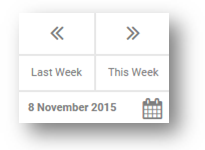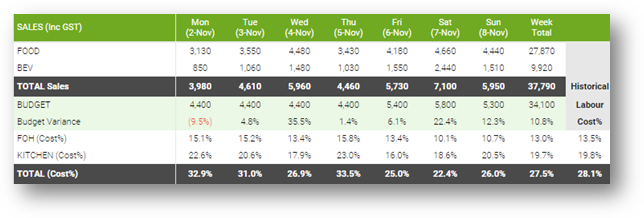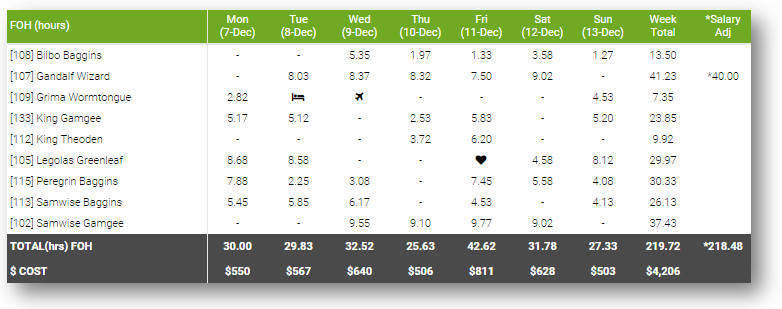Displays a summary of sales and labour information for the selected week, plus entry of employee leave

Navigation:
Use the left (<<) and right (>>) buttons to change to the previous or following week
Or jump to this week, last week, or use the calendar control
Editing of sales or labour hours is not available on this screen, and instead is performed on the timesheet – day page. For convenience, clicking on a day in the header row of any of the tables, will take you directly to that day.
Sales Table:
Displays the daily sales per sales department, and if budgets are set, displays percentage variances to these.
Labour cost percentages are displayed per labour department based on pre-configured calculation methods. The calculation methods can be tailored to client requirements, for example kitchen labour costs can be measured against total sales, or against food sales only (as is the case in the screen shot below).

Historical labour cost percentages are based on what has historically been achieved (over the past year) for similar sales volumes. These are calculated on a per day based, and then rolled up to a weekly value. See historical analysis on how these are calculated.
Labour Tables:
A separate labour table is displayed for each labour department. This displays a summary of the hours for each employee, as well as any leave that has been recorded.
Employees that are setup as salaried, and have had their salary hours for the week confirmed on the payroll page, will display their salary adjusted hours (and labour costs are adjusted accordingly).

Recording Leave:
Clicking on an employee in the table, or clicking on the Record Leave button, brings up the entry screen.
Leave taken is recorded in days for all leave types and would generally be 1 (could be less though, i.e. an employee worked half their shift and then went home sick in which case would be 0.50). The employees leave entitlement is to be reduced by this many days (in the clients payroll system)
Leave to pay is generally recorded in hours except Annual Leave is recorded in days). Is to record what the employee should be paid for. For sick leave,this should represent “what they would’ve worked had they not been sick”.
For each employee, a summary table shows the leave types recorded for this week, and then an entry area where selection of the Leave Type needs to first be made, and then can edit entries for that leave type.

